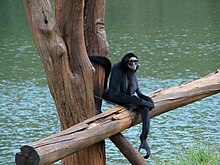
The Atelidae are one of the five families of New World monkeys now recognised. It was formerly included in the family Cebidae. Atelids are generally larger monkeys; the family includes the howler, spider, woolly, and woolly spider monkeys. They are found throughout the forested regions of Central and South America, from Mexico to northern Argentina.

Spider monkeys are New World monkeys belonging to the genus Ateles, part of the subfamily Atelinae, family Atelidae. Like other atelines, they are found in tropical forests of Central and South America, from southern Mexico to Brazil. The genus consists of seven species, all of which are under threat; the brown spider monkey is critically endangered. They are also notable for their ability to be easily bred in captivity.
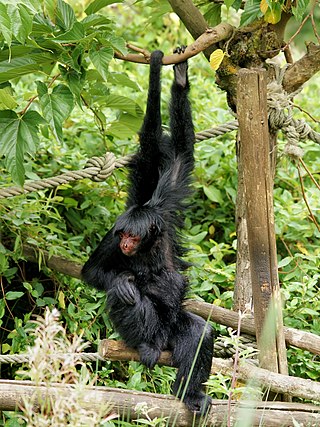
The red-faced spider monkey, also known as the Guiana spider monkey or red-faced black spider monkey, is a species of spider monkey found in the rain forests in northern South America.
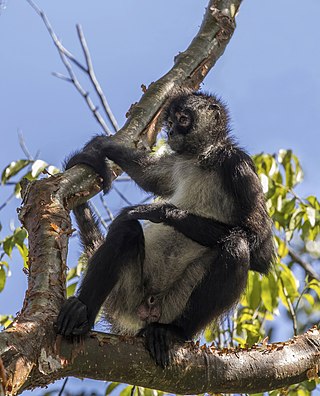
Geoffroy's spider monkey, also known as the black-handed spider monkey or the Central American spider monkey, is a species of spider monkey, a type of New World monkey, from Central America, parts of Mexico and possibly a small portion of Colombia. There are at least five subspecies. Some primatologists classify the black-headed spider monkey (A. fusciceps), found in Panama, Colombia, and Ecuador as the same species as Geoffroy's spider monkey.

The Peruvian spider monkey, also known as the black-faced black spider monkey, is a species of spider monkey that lives in Peru, as well as in Brazil and in Bolivia. At 60 centimetres long, they are relatively large among species of monkey, and their strong, prehensile tails can be up to 1 m (3 ft) long. Unlike many species of monkey, they have only a vestigial thumb, an adaptation which enables them to travel using brachiation. Peruvian spider monkeys live in groups of 20–30 individuals, but these groups are rarely all together simultaneously. The size and dynamics of the resulting subgroups vary with food availability and sociobehavioral activity. They prefer to eat fleshy fruit, but will change their diet in response to scarcity of ripe fruit. Individuals of this species also eat small animals, insects and leaves based on availability. Females separate from the band to give birth, typically in the fall. These females inhabit a group of core areas where resources are abundant in certain seasons. Typically, males exhibit ranging over longer distances than females, with movement of individuals enhancing the fluidity of subgroup size. Peruvian spider monkey are independent at about 10 months, with a lifespan of about 20 years.

The black-headed spider monkey is a type of New World monkey, from Central and South America. It is found in Colombia, Ecuador, and Panama. Although primatologists such as Colin Groves (1989) follow Kellogg and Goldman (1944) in treating A. fusciceps as a separate species, other authors, including Froelich (1991), Collins and Dubach (2001) and Nieves (2005) treat it as a subspecies of Geoffroy's spider monkey.

The brown-headed spider monkey is a critically endangered subspecies of the black-headed spider monkey, a type of New World monkey, found in northwestern Ecuador.

The Colombian spider monkey is a subspecies of the Black-headed spider monkey, a type of New World monkey, found in Colombia and Panama. Some authorities, such as Froelich (1991), Collins and Dubach (2001) and Nieves (2005), do not recognize the Black-headed spider monkey as a distinct species and so treat the Colombian spider monkey as a subspecies of Geoffroy's spider monkey.

The Tapajós National Forest is a Brazilian national forest in the state of Pará, Brazil. It supports sustainable exploitation of the natural resources in an area of Amazon rainforest.

The Azuero spider monkey is a possible subspecies of spider monkey that is in critical danger of extinction according to the IUCN Red List of Threatened Species. Common names of this subspecies include mono charro, mono charao and mono araña. The Azuero subspecies is one of three types of spider monkeys in Panama; Ateles geoffroyi panamensis with a range spanning from Costa Rica to Darién excluding the Azuero, Ateles geoffroyi fusciceps, with a range spanning Panamá and Colón provinces, and Ateles geoffroyi azuerensis, the Azuero spider monkey, whose range encompasses only the Azuero Peninsula.
The Nascentes da Serra do Cachimbo Biological Reserve is a biological reserve in the state of Pará, Brazil. The reserve protects an area in the transition between the Cerrado and Amazon biomes, supporting highly diverse flora and fauna including many endemic species. It is accessible via the BR-163 highway, and is among the federal conservation units in the Amazon Legal that has suffered most from deforestation.

Rio Novo National Park is a national park in the state of Pará, Brazil.

Terra do Meio Ecological Station is an ecological station (ESEC) in the state of Pará, Brazil.
Altamira National Forest is a national forest in the state of Pará Brazil.

The Crepori National Forest is a national forest in the state of Pará, Brazil. It is home to rich biodiversity including several endangered animal species.
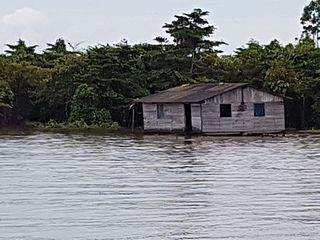
The Gurupa várzea (NT0126) is an ecoregion of seasonally and tidally flooded várzea forest along the Amazon River in the Amazon biome.

The Madeira-Tapajós moist forests (NT0135) is an ecoregion in the Amazon basin. It is part of the Amazon biome. The ecoregion extends southwest from the Amazon River between its large Madeira and Tapajós tributaries, and crosses the border into Bolivia. In the south it transitions into the cerrado biome of Mato Grosso. In the state of Rondônia it contains some of the most degraded land of the Amazon basin.
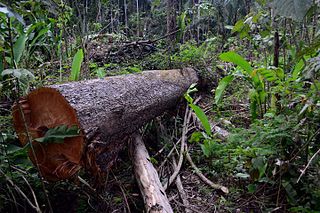
The Tapajós–Xingu moist forests (NT0168) is an ecoregion in the eastern Amazon basin. It is part of the Amazon biome. The ecoregion extends southwest from the Amazon River between its large Tapajós and Xingu tributaries.

The Xingu–Tocantins–Araguaia moist forests (NT0180) is an ecoregion in the eastern Amazon basin. It is part of the Amazon biome. The ecoregion is one of the most severely degraded of the Amazon region, suffering from large-scale deforestation and selective extraction of timber, particularly along the Trans-Amazonian Highway and in the higher and more populated southern portions.

The Mato Grosso tropical dry forests (NT0140), also called the Mato Grosso seasonal forests, is an ecoregion in central Brazil to the south of the Amazon region. It contains vegetation in the transition between the Amazon rainforest to the north and the cerrado savanna to the south. The opening of highways through the region has caused rapid population growth, deforestation and pollution.
